Anni Albers – Exhibition at Tate Modern
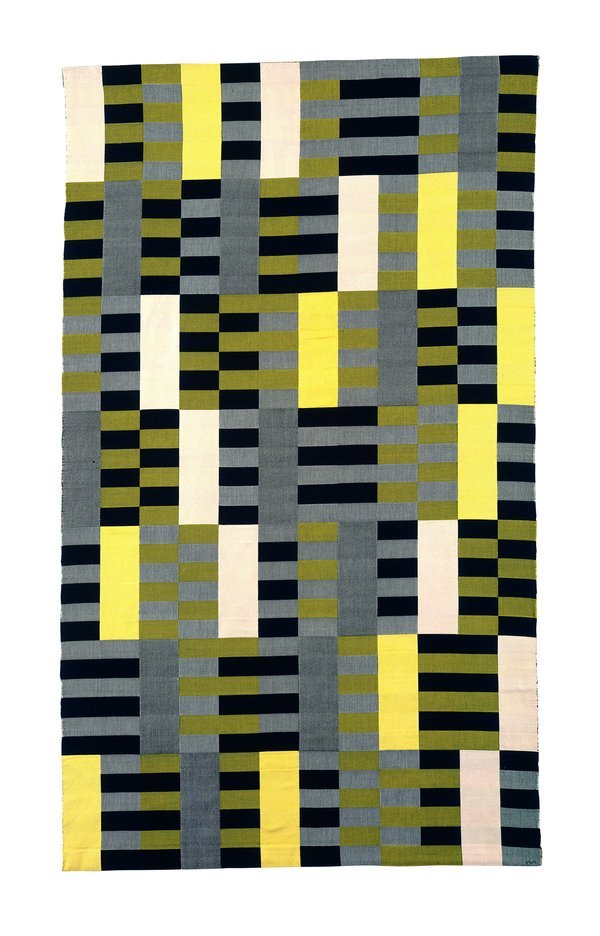
Anni Albers combined the ancient craft of hand-weaving with the language of modern art
I'm really looking forward to this exhibition which opens tomorrow. I only became aware of Anni Albers recently, although, inevitably, I knew of her husband, Josef Albers. Here's a small collection of reviews, pictures and links for your edification followed by a selection of samples of Scandinavian embroidery and pattern darning from a recent folio workshop at the Embroiderers' Guild.
Guardian Arts Review - ravishing textiles that beg to be touched.
Albers’ hand-woven art is a lesson in colour and geometry, method and singularity; tactile and optical, spatial and utilitarian; most of all, her work gives pleasure, and this exhibition (organised in conjunction with K20 in Dusseldorf) is a revelation and a delight.

Ancient Writing, 1936. Photograph: Smithsonian American Art Museum/Josef and Anni Albers Foundation/ARS, New York/DACS, London - from the Guardian
The Standard: Anni Albers - five things you need to know.
As a pioneering textile artist at the forefront of the modern agenda, Albers changed the way artists approached “crafts” in relation to making art.
Visiting London Guide - Exhibition Review.
Embroiderers Guild Folios
Last week I wrote about the Embroiderers' Guild and their collection of folios. Each folio is made up around a theme - maybe from a geographical area or a type of embroidery or stitch.
Each of these folios is available free of charge (except for the cost of return postage) to local branches of the Guild. The one I belong to, in Market Harborough, has a folio evening three times a year, when members get a chance to study a theme and try out some of the stitches and techniques.
Our recent folio evening had samples of pattern darning and Scandinavian embroidery. The thing that struck me about both of these was how meticulous they were. I couldn't imagine having the patience (or the eyesight) to do any of these, although they were exquisite.
Scandinavian Embroidery
I loved the bright colours and sampler style stitches of this cushion cover from Sweden. But what it made especially interesting to me was that, in patches, it was showing signs of wear and stitches had unravelled or disappeared. I love the visual tension this creates.
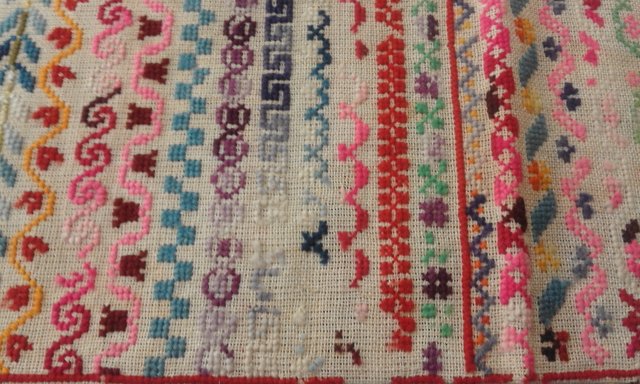
This linen cuff embroidered in wool is from Norway - you can see the links with other textile patterns from Norway used in knitting especially. I liked the suggestion that this was a decorative piece added and removed from garments when they needed laundering or replacing. I especially liked the density and richness of the colours. They look warm.
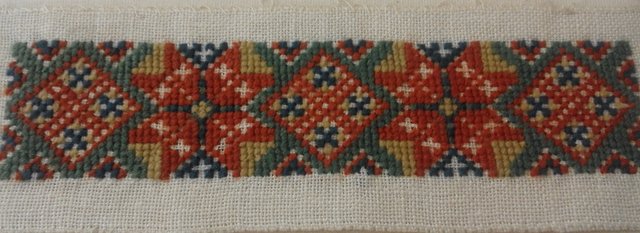
This linen cushion cover embroidered in blue from Denmark caught my eye, too (like those lovely ceramic buttons I shared recently). Each plant pot is individual and I like the lovely tension between the silhouettes and background.
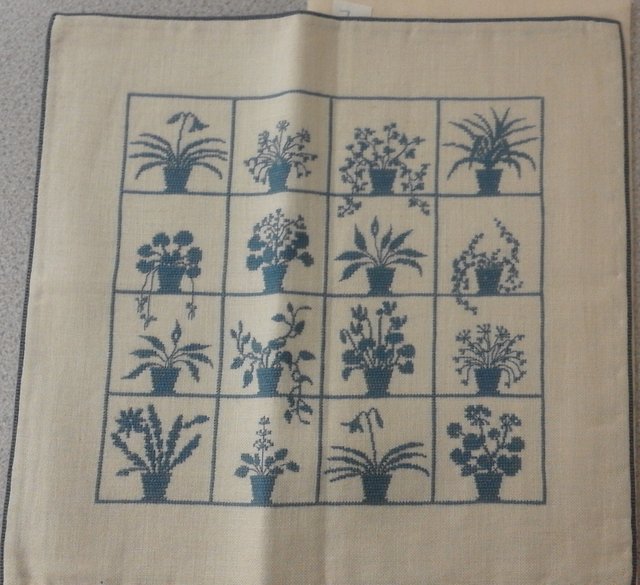
Pattern Darning
Again, meticulous work using counted thread techniques. Sadly, there was no background material explaining the sources of the various items or how they had come to be in the Guild's collection. Mind you, I imagine they have piles of stuff gifted to them - it must be a bit of a nightmare job for a curator.
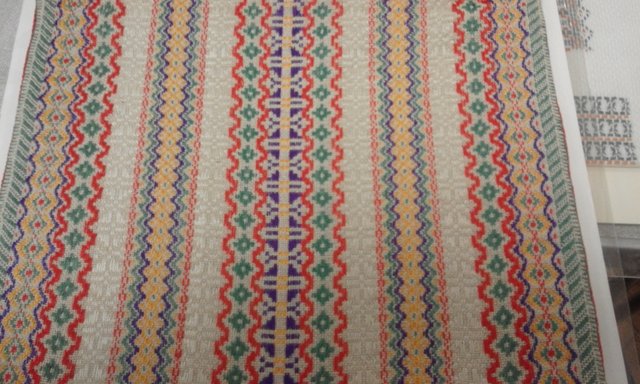
This was the body of a small bag which had an embroidered strap to match. It looked like it had never been used, unlike the worn cushion cover above. There was a small workshop running during the meeting where some of these psatterns had been charted and people were trying their hand at them. Not me, though, I went for a cup of tea and a chat with Joy about crochet.

I did like this border (a theme here, I'm falling for the blue shades) and the contrast between stitch and ground. This one, more than any of the others, compels me to start experimenting, maybe using some printing dyes and repeat patterns. I wonder if I could get that crispness, or perhaps a more murky, hazy pattern would develop.
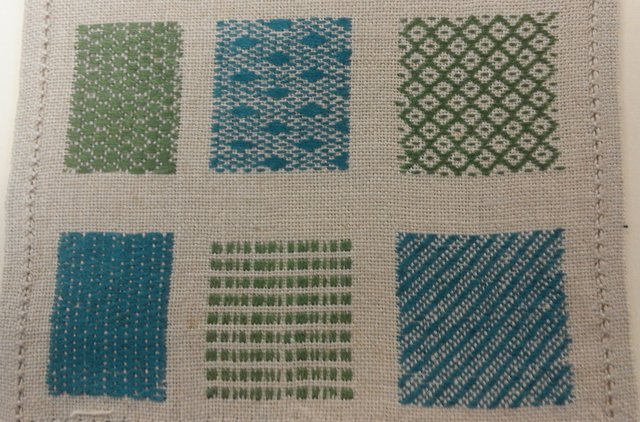
A sampler tray cloth, also linen, which I suppose is ideal for counted thread work. We have some counted thread embroiders in the branch and they do make exquisite work - but more as art items than the practical uses these items would have had.
I'm feeling that there's a link between these and Anni Albers' work - different ends of the spectrum? Requires more thinking.
Source of shared Link

@shanibeer thanks for sharing Annie Albers' work! I wasn't familiar with her. Beautiful and inspiring! The embroidery folios are beautiful in a different way, though I get what you mean a little about similarities. For me, textile crafts have such dimension. You can feel them just by looking. I experienced that a lot in the Alber pieces. Also, I love her weavings featuring squares. I wonder if she became inspired to do them after sorting through her sample swatches like the folios from the embroidery guild.
I'm really glad you appreciated the post. For me, it's something about becoming immersed and in some way the folio samples and her tapestries are connected. You must also look at @neumannsalva's post about her sculpture - It is molten, Henrietta, run.
Hi @shanibeer!
Your post was upvoted by @steem-ua, new Steem dApp, using UserAuthority for algorithmic post curation!
Your UA account score is currently 2.791 which ranks you at #12168 across all Steem accounts.
Your rank has improved 908 places in the last three days (old rank 13076).
In our last Algorithmic Curation Round, consisting of 471 contributions, your post is ranked at #412.
Evaluation of your UA score:
Feel free to join our @steem-ua Discord server